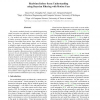Free Online Productivity Tools
i2Speak
i2Symbol
i2OCR
iTex2Img
iWeb2Print
iWeb2Shot
i2Type
iPdf2Split
iPdf2Merge
i2Bopomofo
i2Arabic
i2Style
i2Image
i2PDF
iLatex2Rtf
Sci2ools
ICCV
2011
IEEE
2011
IEEE
Real-time Indoor Scene Understanding using Bayesian Filtering with Motion Cues
We present a method whereby an embodied agent using visual perception can efficiently create a model of a local indoor environment from its experience of moving within it. Our method uses motion cues to compute likelihoods of indoor structure hypotheses, based on simple, generic geometric knowledge about points, lines, planes, and motion. We present a single-image analysis, not to attempt to identify a single accurate model, but to propose a set of plausible hypotheses about the structure of the environment from an initial frame. We then use data from subsequent frames to update a Bayesian posterior probability distribution over the set of hypotheses. The likelihood function is efficiently computable by comparing the predicted location of point features on the environment model to their actual tracked locations in the image stream. Our method runs in real-time, and it avoids the need of extensive prior training and the Manhattan-world assumption, which makes it more practical and ef...
| Added | 11 Dec 2011 |
| Updated | 11 Dec 2011 |
| Type | Journal |
| Year | 2011 |
| Where | ICCV |
| Authors | Grace Tsai, Changhai Xu, Jingen Liu, Benjamin Kuipers |
Comments (0)

